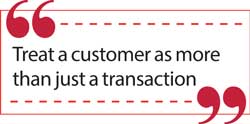Saturday Oct 11, 2025
Saturday Oct 11, 2025
Wednesday, 8 October 2025 00:20 - - {{hitsCtrl.values.hits}}

 Mission: Possible 2025 Customer Experience Week
Mission: Possible 2025 Customer Experience WeekFor many years, customer satisfaction was measured through surveys carried out with a close-ended question: “How satisfied were you with your service experience?” It was a “Yes” or “No” response in which many were comfortable with more “Yes” answers as the scores. But in 2025, relying on satisfaction alone is complacency. It only tells you how a customer felt at that moment in time. It is in no way a guarantee that the customer will remain with you, make repeat purchases, or create favourable word of mouth in the future.
It is important to understand that in reality loyalty is not just a feeling; it is a behaviour. A customer who continuously patronises a brand does so because of a memorable experience. A customer may be satisfied with an offer made at that moment in time and yet prefer a competitor brand at the first sign of a better price or convenience. To win in the modern market, the C-Suite must adopt metrics that measure future value, not just past satisfaction.
Hence, it is recommended to use the following two measurement metrics: Customer Effort Score (CES) and Net Promoter Score (NPS).
Possible usage of Customer Effort Score (CES)
Customer Effort Scores are a tangible measure of customer experience. It is a single metric that measures the amount of effort a customer must use to interact with a company or use its products or services. Using this metric helps companies to understand the health of their customer experience.
A typical question in conducting a CES survey is to ask customers to rate “how easy it was to resolve your issue” on a numerical scale, such as 1 (‘very low effort’) to 5 (‘very high effort’). The CES is calculated by taking the total sum of all responses and dividing it by the total number of respondents to find the average score. A lower effort CES score indicates that the company is providing good customer experiences. It suggests that customers are more loyal to a service that is easier to use. A higher effort CES score is likely a sign of something wrong in an aspect of the user experience that is demanding more effort from the customer. CES is easy to deploy and track over time and is best suited for measuring customer loyalty.
Organisations should pay particular attention when providing services through 24-hour hotlines, launching new products or services, or introducing special offers. They must ensure adequate resources are in place for customers to easily access the service provider. If customers face long queues on phone lines with delayed responses, or if sales staff take a long time to attend to requirements, this creates a higher CES which may damage loyalty. Saying “We never expected this many enquiries or footfalls” is not a valid excuse. The reality is simple: if you delay, someone else will attract the customer.
 A landmark study in the Harvard Business Review by Dixon, Freeman and Toman (2010) found the predictive power of CES to be strong. Of the customers who reported low effort, 94% expressed an intention to repurchase, and 88% said they would increase their spending. Conversely, 81% of customers who had a hard time solving their problems reported an intention to spread negative word of mouth.
A landmark study in the Harvard Business Review by Dixon, Freeman and Toman (2010) found the predictive power of CES to be strong. Of the customers who reported low effort, 94% expressed an intention to repurchase, and 88% said they would increase their spending. Conversely, 81% of customers who had a hard time solving their problems reported an intention to spread negative word of mouth.
Ease, it turns out, can be even more powerful than delight.
Possible usage of Net Promoter Score (NPS)
Net Promoter Score is the most widely used customer experience metric. NPS is based on a single question asked of the customer: “How likely are you to recommend us to another?” The objective is to measure loyalty by assessing the likelihood of recommendation. An NPS survey uses a scale from 0 to 10. Customers who rate 0 to 6 are unhappy customers, known as detractors. Those who score 7 to 8 are passives. Customers who score 9 to 10 are promoters.
The NPS is calculated by subtracting the percentage of detractors from the percentage of promoters. This produces a score between -100 and +100, which indicates overall perception and brand loyalty. Promoters are loyal customers who are happy to share their positive experiences. Detractors are customers who move away from the service provider, spreading negative word of mouth, sometimes with exaggeration.
NPS is an important measure for assessing loyalty, as it directly correlates to business growth and revenue. Once businesses identify promoters, they can encourage them to act as brand advocates. By analysing feedback from detractors, businesses can also make improvements to retain and attract customers.
Carrying out surveys requires significant investment in terms of time, money and effort. These surveys should not be done for the sake of reporting results. Metrics are of little use if they do not drive action. What is needed is in-depth study to assess the root causes behind customer responses. Insights must be used to remedy situations quickly, ideally within hours rather than weeks, to improve the business. Customers must feel that their feedback is valued and used for the benefit of all stakeholders.
The transition from satisfaction to loyalty metrics is not about abandoning old tools but about upgrading the dashboard. In 2025, the companies that thrive will be those that measure what truly predicts the future.
(The writer is a sought-after ‘Customer Experience’ specialist in Sri Lanka. Over the last three decades he has conducted nearly 3,500 inspirational and educational programs for over 800 organisations in 11 countries. His work can be seen at www.dhammikakalapuge.com.)